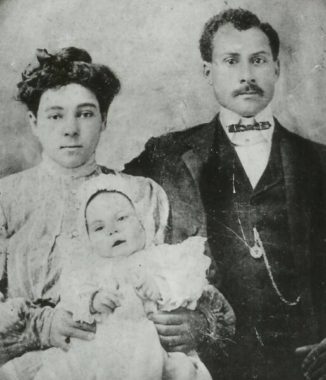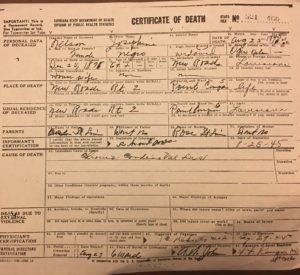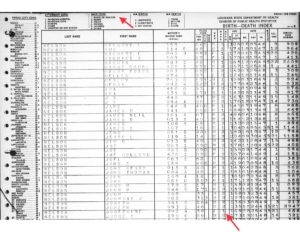“White or Mexican(White)” is what I saw in a death record on Ancestry.com back in 2010 while researching my great grandmother Josephine Nelson, née St. Louis. This came as quite a surprise to me especially since I was new to genealogy and assumed that all of my ancestors were rich shade of brown like me and also from Louisiana, not Mexico!
Needless to say, this label has left me and other family researchers perplexed. Based on the queries and information that I have seen, this label appears to have been given to deceased individuals throughout Louisiana regardless of their ethnicity or whether they identified as Creole or not. Their families were probably unaware of how they had been recorded in this index and in other government records that tracked race, including census records. What also confused me was that around the same time that I discovered this death index record, I learned through a traveling Museum exhibit called The African Presence in Mexico, From Yanga to the Present , that Creoles and other free persons of color did in fact migrate and settle in Mexico. I had also noticed that there were people in census records from Mexico who made Louisiana home. I do not have a picture of her however I suspect that she and the St. Louis/Pauls may have resembled the family in the feature image. The idea that Josephine would have actually identified as either “White or Mexican” and would try to “pass” in a small community where everyone knew her seemed a bit far fetched and here is why.
Josephine Revealed
Josephine Nelson or “Mamma Jo”, is my mother’s paternal grandmother. According to Catholic records she was born 1873 in New Roads, Pointe Coupee, Louisiana to Oscar St. Louis, who had been enslaved and Marie Rose St. Louis, née Paul. Raised in a household where both parents spoke Louisiana Creole and she was the second of four sisters, Marie Eleanore (b. 1871), Marie Victoria (b. 1876), and Marie Eugenie (b. 1878) . She would go on to marry Auguste Nelson , another Pointe Coupee Parish native from Brooks in 1888 at the tender age of fifteen. They had twelve children, one of which was Albert Nelson, my paternal grandfather. DNA testing of her descendants yield DNA matches that strongly suggest her most recent ancestors were from Pointe Coupee and not Mexico or Europe.
My mother has vague memories of Mamma Jo and described her as being a stern, no nonsense women in a wheel chair. She said that Mamma Joe was in a wheel chair because her leg was amputated after she was bitten by an insect while tending her garden . Infection and necrosis set in and her leg was amputated. My mother get’s annoyed because she said that people assumed that her leg was amputated because she was diabetic. Yet she was not. We both get annoyed because the leg probably would not have been amputated had she had access to better health care.
The Death Records
According to her death certificate, she would eventually pass away in 1945 at the age of sixty-nine in her home town of New Roads, Louisiana. In the “Length of Stay in this Community” box on the death certificate was written “life”. So it seems that she probably lived in Pointe Coupee Parish all of her life. It is common knowledge that death certificates have there share of mistakes. Along with being a source of more reliable primary information, they are also a source of less reliable secondary information.
| Name: | Josephine Nelson |
|---|---|
| Event Type: | Death |
| Event Date: | 25 Aug 1945 |
| Event Place: | New Roads, Pointe Coupee, Louisiana |
| Gender: | Female |
| Age: | 69 |
| Race: | Negro |
| Birth Year (Estimated): | 1876 |
| Birthplace: | New Roads, Louisiana |
| Father’s Name: | Anton St Louis |
| Mother’s Name: | Rose St Louis |
| Spouse’s Name: | Ogus Nelson |
| Certificate Number: | 521466 |
The information shown in the above table is an index record of Josephine’s actual Death Certificate in Louisiana Deaths, 1850-1875, 1894-1960 on Familysearch.org. It is attached to an actual image of the death certificate (Figure 1). If you want to view a death certificate image you must access it from this collection at a FamilySearch Research Center or affiliated library. They are generally not view-able from home.This index is different from the Louisiana Statewide Index Information found on Ancestry.com.
“Secondary information would include the deceased’s birth date, birth location, and the names and birth places of the parents. This information is the responsibility of the informant, who, despite often being a family member or friend, was not typically present at the actual birth of the individual, and is often providing this information second- or even third-hand.”1
The informant on Josephine’s death certificate was Richard Jones, her son-in-law. In the previous census he was living next door with his wife Vernetta, one of Josephine’s daughters. In the birth place boxes for her parents, there is a “Don’t No”. So fortunately, I had Catholic Records from the Diocese of Baton Rouge that documented their births in Pointe Coupee Parish. I have found that a number of my ancestors death certificates are missing basic secondary information and it sometimes has made me wonder about the information collection process.
Like so many she was somewhat of a “census chameleon“, though she was never labeled “white” in the U.S. Federal Census records that I was able to locate. Here is a rundown of how Josephine’s race was labeled throughout her life.
| U.S. Federal Census | Josephine’s
Race |
| 1880 | ????????? |
| 1900 | Black |
| 1910 | Mulatto |
| 1920 | Black |
| 1930 | Negro |
| 1940 | Negro |
US Federal Census Racial designations for Josephine St. Louis
The Louisiana, Statewide Death Index, 1819-1964 , is accessible from Ancestry.com and contains approximately 2,081,698 records. According to genealogist Judy Riffel, who provided the image of the index page listing for Josephine (Figure 2), these records were created from OCR scans of the actual Louisiana Vital Records Statewide Death Index on Microfilm at the State Archives. According to Judy, the actual entries in the statewide death index were created after the death certificates were generated.
Within this repository are approximately 112,342 records of individuals who died from the mid 1930’s to 1949 that contain “White or Mexican(White)” in the race field. I have included several Ancestry.com entries for Josephine, her son, Albert Nelson, and his mother-in-law Elnora Jones so that you can see other ways that people of color were labeled in this record collection during that time.
| Name: | Josephine Nelson |
|---|---|
| Gender: | Female |
| Race: | White or Mexican (White) |
| Age: | 69 |
| Birth Year: | 1876 |
| Death Date: | 25 Aug 1945 |
| Death Place: | Pte. Coupee, Louisiana, USA |
| Volume: | 21 |
| Name: | Albert Nelson |
|---|---|
| Age: | 48 |
| Birth Year: | abt 1896 |
| Death Date: | 1 Dec 1944 |
| Death Place: | Point Coupee, Louisiana, USA |
| Name: | Elenora Jones |
|---|---|
| Gender: | Female |
| Race: | Negro (Black) |
| Age: | 49 |
| Birth Year: | 1894 |
| Death Date: | 6 Aug 1943 |
| Death Place: | Pte. Coupee, Louisiana, USA |
Death Index Dilemma
So why was this seemingly odd “White or Mexican(White)” label used for certain deceased persons and not others? Was this done in other states? Was the family consulted about her identity? Did the family ever know that this designation was listed as such in this statewide death index? Why did the death certificate say something different? Why wasn’t the information recorded in the statewide death index taken from the death certificate? Was it just a transcription error? Why was White and Mexican designated under one code on the actual statewide index? My theory, perhaps they were trying to incorporate and simplify complex guidelines regarding persons of Mexican origin that were found in the 1930 and 1940 census instructions.
In the 1930 Census Instructions to enumerators, there were specific instructions for reporting race.
“A person of mixed White and Negro blood was to be returned as Negro, no matter how small the percentage of Negro blood; someone part Indian and part Negro also was to be listed as Negro unless the Indian blood predominated and the person was generally accepted as an Indian in the community.
A person of mixed White and Indian blood was to be returned as an Indian, except where the percentage of Indian blood was very small or where he or she was regarded as White in the community. For persons reported as American Indian in column 12 (color or race), columns 19 and 20 were to be used to indicate the degree of Indian blood and the tribe, instead of the birthplace of father and mother.
In order to obtain separate figures for Mexicans, it was decided that all persons born in Mexico, or having parents born in Mexico, who were not definitely White, Negro, Indian, Chinese, or Japanese, would be returned as Mexicans (Mex).
Any mixture of White and some other race was to be reported according to the race of the parent who was not White; mixtures of colored races were to be listed according to the father’s race, except Negro-Indian (discussed above).”
In the 1940 census instructions to enumerators , the following was written:
“With regard to race, the only change from 1930 was that Mexicans were to be listed as White unless they were definitely Indian or some race other than White.”
Whew! Did you catch all of that? I am not sure who to feel sorry for , the census takers or those being counted. I noted the particular attention payed to persons of Mexican origin.
I would go on to learn that this was just one example of the many instances that federal, state, and local government entities have historically mislabeled individuals and groups whether intentionally or not. Maybe Josephine’s labeling was a mistake, a recording or transcription error. Even if it was not, I think she just would have wanted the record to be an accurate reflection of how she herself identified herself, as neither White or Mexican, no disrespect to either group, but as a Creole, Negro, Black, or Colored woman.
So have you encountered any odd labels or classifications while researching ancestors? Please post a comment and share it with us! Thanks for stopping by and if you would like more death record resources to help with your research, sign up to receive blog post notifications!
1Allison. “Death Certificates: Both a Primary and Secondary Source” LegacyTree Genealogists, Apr.2015, https://www.legacytree.com/blog/death-certificates-both-a-primary-and-secondary-source



Kristin
I’ve never had anyone labeled as Mexican. Some people changed from census to census from “mulatto”, “black”, “Negro”, “white”, “Cherokee”.
Marsha Sampson-Gilliam
In the book by William Loren Katz titled Black Indians; contains a chapter of Twenty Years In Mexico, Tells how escaped slaves joined the Seminole Indians how some of the Blacks and Indians migrated in 1829 to Mexico. pg. 73 This also explains ex-enslaved people descendants being of Mexican heritage.
Karen Galloway Post author
Thanks Marsha. Now that you mention it I do remember reading about the underground railroad going into Mexico.
William C. "Chip" Morrison
Interesting read of going down the road so to speak. Yes, the enumerators had a tough job. My mother did that job in 1950. Things were still dicey then, improved in the 60s and is probably done correctly and humanely today. Brooks a locality no longer exists. The area is generally known as “Pointe Coupee” or “Pointe Coupee Road.” The more snobbish folks would say “the Coast of Pointe Coupee.” The area is still mostly farm land. The address is Route 2, New Roads and the box number. Last time I was out there, I notice all the old Black churches are in sad disrepair. No congregations much anymore. St Francis Chapel remains okay and most of the burials are from Black families. My family, white, still use it and I help bury my sister in June of this year. We keep our plot up and the only others are the Labatut family. Our Black brothers and sisters far out weight in the number with well kept graves behind the church.
Karen Galloway Post author
Hey Chip! Thanks for the history! Josephine’s mother Rose/Rosa had “Morrison” listed on her death certificate as her employer. I am so sad about the churches. They still bury people at 6th Ward Baptist Church.
Tommie
My great-aunt was the youngest of 12 children born to a black mother and “mulatto” father. She had the fairest complexion of the bunch of many-shaded siblings. We were shocked to see that on her death certificate (issued in Shreveport, LA), she was identified as “Mexican (white).” Clearly no family member provided that information. We feel that the medical examiner simply applied the “logic” outlined in this article.
Karen Galloway Post author
Tommie,
Interesting. So your great aunt’s death certificate had the designation in addition to what was listed in the death index? Josephine’s said “Negro”. I wondered why the information in the index was not taken from the death certificate. I was told by a noted genealogist that it was probably an “error”. I would definitely encourage others who have family/ancestors with the designation to compare it to the death certificate.
visit the next site
Hello. remarkable job. I did not expect this. This is a splendid story. Thanks!
Crystal Johnson
Hello. I am glad you wrote this. My great great great grandfather (LaPointe/Guidry) from Rayne by way of Church Point, St Martin also had Mexican on one of his documents. He died around 1945.
I just chuckled because I thought they just bundled people up into category that they think a person belonged to. But we know Mexican is not a race.
Super Woman
Hi Crytal, thanks for visiting my site and sharing your ancestors story. Exactly, just lumped them all together and slapped a label on!